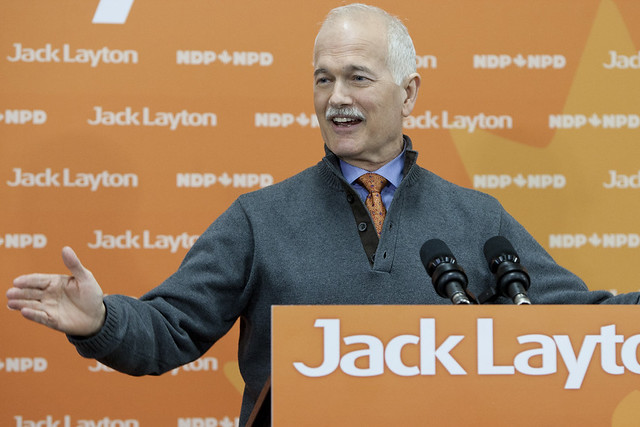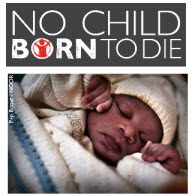New Democratic Party (NDP): Family, Parenting and Women's Issues
 Tuesday, April 19, 2011
Tuesday, April 19, 2011 This week, I'll be posting highlights from the platforms of Canada's five major political parties, focusing on their policies and promises with regards to family, parenting and women's issues. I am going to try (but do not promise!) to simply report on or summarize what they have promised, rather than providing colour commentary in my posts. However, I am happy to have detailed conversations about the value and feasibility of the proposals in the comments on each post.

- Image credit: NDP
New Democratic Party (NDP)
The NDP's platform is available online at http://www.ndp.ca/platform and its tagline is "leadership you can trust to give your family a break."
Some of the key promises that relate to families, parents and women include:
Benefits to allow people to care for their families
- More generous and flexible benefits to allow people to take up to six months leave from work to tend to relatives near the end of their lives (currently six weeks).
- New Caregiver Benefit of up to $1500 per year (similar to Child Tax Benefit) to help low and middle-income families care for children, spouses, parents and other family members.
- Target child poverty with new non-taxable Child Benefit (in addition to existing Child Tax Benefit and Universal Child Care Benefit) that would increase support by up to $700 per child over the next 4 years, in addition to setting goals and targets for poverty reduction with other levels of government.
- If your family includes small business owners, a family farm, or tradespeople, there are additional benefits that could help your family.
Childcare and education
- Canada-wide child care and early learning program that includes 100,000 new childcare spaces over the next 4 years (25,000 per year), as well as investments in the community infrastructure required to support child care. The community-based child centres would provide parents with a one-stop-shop for family services.
- More affordable post-secondary education through direct transfer of $800 million to the provinces and territories to help them lower tuition fees.
- Increased funding to Canada Student Grants program of $200 million per year, targeting accessibility for Aboriginal, disabled and low-income students in particular.
- Raising education tax credit from $4,800 per year to $5,760 per year to help with increasing education costs.
Helping families reduce costs
- Reinstating the Rehabilitation Assistance Program (RRAP) and Affordable Housing Initiative, among other things, to provide more affordable housing for Canadian families.
- Initiatives aimed at promoting energy efficient homes and helping families cover the costs of heating their homes.
- Credit card interest rates of no more than 5% above prime.
- Implementing a variety of procedures to reduce the prices of prescription medication.
- National minimum wage.
- Variety of initiatives to encourage clean energy production and strengthen public transit.
Women's Rights
- Variety of initiatives aimed at addressing gaps in women’s equality, such as reversing the Conservatives attacks on pay equity, restoring funding to women’s programs, expanding access to shelter and transition houses for women fleeing violence, improving support to aboriginal women (especially victims of violence), and ensuring that using maternity/parental leave benefits does not change an individual’s eligibility for Employment Insurance benefits.
- Re-affirming women's rights to safe, accessible abortion services.
Healthcare
- Guaranteed commitment to our single-payer public health care system.
- Measures to address the shortage of doctors, nurses, midwives and other health care professionals (including programs to recruit and support low-income, rural and aboriginal medical students).
Children's Health and Safety
- Children’s Nutrition Initiative to support and expand provincial and local programs that provide healthy meals to school children, while also increasing emphasis on food safety and proper labelling of food.
- Implement a strategy for reducing serious injuries in amateur sport.
- Plans to hire more police and give parents, teachers and police more tools to protect children by making gang recruiting illegal and implementing initiatives to ensure that prisons do not serve as “crime schools”.
What do you think of the NDP platform? Do their promises sound like a good fit for your family? For our country?
Please also check out my Care2 Causes post called Tools to Help You Navigate the Canadian Election and my Bad Moms Club post called If the Political Parties Were Bad Moms. If you want to discuss politics with other moms, also be sure to check out the #momthevote hash tag on twitter and the Mom The Vote facebook page.




















Reader Comments (53)
I came across this blog on my friend's facebook, and she is voting NDP, so we were having a nice discussion over on her page as well. I usually just don't have much time to write comments though. My husband and I are currently discussing all the options. It's fun to dream and try to come up with solutions for our country!
[...] New Democratic Party [...]
I like the idea of transferring more money to the provinces for postsecondary, but I'd want to know:
-Will the money go to the provincial government, or directly to the institutions? If to the institutions, who decides how much money each institution gets, and will the amounts differ by level/type of school (trade school/college vs. university, public vs. religious). If it goes to the provincial government, how do you make sure the money actually gets to institutions?
-What kind of restrictions will be on the money? Will universities be able to use it to build new facilities and support more research (which they'd probably prefer), or will they use it to decrease undergraduate class sizes and pay professors a more respectable salary (which I'd certainly prefer)?